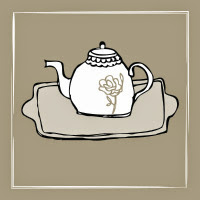Darjeeling tea is tea that is grown in the Darjeeling district of India and is known as the "Champagne" of teas. Tea from this region is some of the best in the world.
Plucking season begins with the first flush of new growth in March and April. Following a short period of dormancy, the plants put forth a second flush that is picked from May into June. The summer months bring daily heavy rains from July until September, yielding a monsoon flush. (I was surprised to find that some of the gardens had switched to green tea production during the high yield monsoon season to secure large international contracts.) The autumnal flush is picked in October and November. The cold winter months of December to February are a period of dormancy.
Two and one-half acres yield an average of only 1,200 pounds of dry tea (less than a third of the yield of gardens in Assam or Nilgiri). Each Darjeeling tea bush yields only 3 - 4 ounces of processed tea in a year. Each pound of fine tea consists of more than 9,000 individually hand plucked shoots!
In Darjeeling what is called a garden is actually a large plantation that may cover 1,000 or more acres, and cover 1,000 feet in altitude. These plantations, established by the British in 1852, are home to hundreds of workers and their families. Most are self contained communities with their own school, hospitals and temples.
No other tea in the world carries the
distinctive muscatel overtones and bright coppery color of a tea from
the Darjeeling region of North Eastern India. Its appearance, liquor
and aroma are instantly recognizable by tea drinkers worldwide. A
Darjeeling China bush will not produce the same muscatel tones if taken
from its nest on the mountain and planted in the lowlands of Dooars or
Assam. Darjeeling teas owe their unique flavor partly to the type of
bush and partly to the climate.
Yet it is estimated that 40 million
kilograms of tea, often marked as “Pure Darjeeling,” finds its way
into the market each year. This counterfeit tea may be a copper-colored
light tea grown and processed in Sri Lanka or Kenya, or it might be
tea brought across the mountains from neighboring Nepal, Sikkim or
Bhutan. The Tea Board of India and the Darjeeling Tea Association have
decided that to protect their unequalled reputation - and prices -
their product must be trademarked and verified.
To make the name Darjeeling
distinctive, the Tea Board of India has designed a logo now used by all
producers, packers and exporters of Darjeeling tea. Application must
be made with the Tea Board of India for its use. Hopefully, this branding will give
assurance to consumers that they are buying authentic Darjeeling tea.
We now have some beautiful Darjeeling 1st and 2nd flush teas for 2012 in store:
DARJEELING 1ST FLUSH - SOURENEE RANI CLAWS - ORGANIC
One of the finest offerings of the Darjeeling 1st flush season from an organic garden. A very fine tea!
DARJEELING 2nd FLUSH - DOOTERIAH SFTGFOP 1 CH MUSCATEL
This
beautiful offering from Dooteriah is probably
among the best 2nd Flush 2012 teas we will see from Darjeeling this
season.
The leaf is coppery brown with a generous percentage of silver tips present. The aroma on opening the packet of dry leaves is distinctly 'Muscatel'. It promises a very brisk cup and it sure delivers on it's promise.
It brews a deep golden liquor and has a slightly oaky bouquet.
The leaf is coppery brown with a generous percentage of silver tips present. The aroma on opening the packet of dry leaves is distinctly 'Muscatel'. It promises a very brisk cup and it sure delivers on it's promise.
It brews a deep golden liquor and has a slightly oaky bouquet.












No comments:
Post a Comment